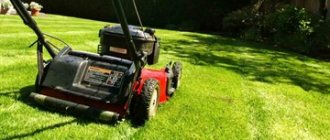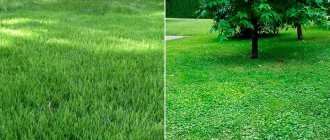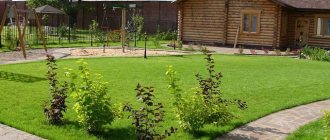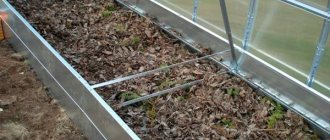Description and characteristics of the grass mixture
The main qualities of Lilliput lawn, which manufacturers focus on:
- European quality;
- silky low-growing lawn with thick emerald grass;
- a lawn for the lazy, does not require frequent cuttings and special care.
They speak the truth and lie at the same time. The fact is that based on the composition, this is a parterre lawn :
- varieties and varieties of Red fescue;
- thin bentgrass;
- bluegrass Lugovoy.
The last cereal, Poa pratensis, is not used in European top-class coatings.
In Russia, the climate is more changeable; small amounts of Lugovoi bluegrass are usually included in mixes for parterre lawns. But a parterre lawn will lower its “status” to ordinary if it :
- cut rarely, allowing the grass to grow more than 3 cm;
- subject to even minor loads;
- do not carry out a full range of lawn care, and regularly.
You can't even walk on the ground lawn .
If such a need arises, first place a wide board on the grass, and only then step on it. Caring for top-class coatings takes a lot of time and must be carried out by an experienced gardener. For most summer residents or owners of personal plots, such a lawn is too labor-intensive and financially expensive. They will prefer not a parterre lawn, but a regular lawn of high quality, with easier care, on which they can walk.
The grasses included in the Lilliput grass mixture dictate the characteristics of the lawn:
- Any soil is suitable for arranging a lawn, except for heavy clay soils - they need to be diluted with sand;
- on permanently soaking soils it will be necessary to arrange drainage or divert water;
- drought resistance is high, but maximum decorative effect can only be achieved with regular watering;
- tolerates temperature fluctuations well;
- frost resistance is high;
- consists of low-growing, slow-growing, narrow-leaved grasses;
- the Lilliputian lawn comes into force and fully reveals its decorative effect in the second year after planting, when dense turf and dense grass stand are formed;
- disease resistance;
- Rare mowing is allowed;
- can be cut low (3 cm);
- bears light loads.
The last point requires clarification. The more stress the grass surface is exposed to, the lower its quality becomes . On the Liliput lawn you cannot:
- to play football;
- regularly engage in active sports;
- ride a bike;
- walk with a baby stroller.
Can:
- occasionally have picnics;
- sit;
- meditate;
- exercise;
- play for children;
- walk around.
Undesirable on the Lilliputian lawn:
- install a swing;
- leave garden furniture for a long time.
What is a "lazy man's lawn"?
This type of grass lawn fully lives up to its name; it is very easy to use, and there is almost no need to monitor and care for the shoots.
Lawn "Liliput" is a specially bred variety of lawn grasses that grow very slowly. This herbal mixture appeared thanks to a large amount of research by European scientists. This lawn mixture contains 7 main components of meadow grasses. They are supplied to Russia from abroad, more precisely from Europe and Canada. Grass varieties are recognized as slow-growing and unpretentious to different soil climates.
Recent Entries
Chainsaw or electric saw - what to choose for the garden? 4 mistakes when growing tomatoes in pots that almost all housewives make Secrets of growing seedlings from the Japanese, who are very sensitive to the soil
Thanks to the small seeds, 30 grams is enough to sow one square meter of territory. “Liliput” contains at least 15% bentgrass and the same amount of meadow grass.
Composition, manufacturers, photos and prices
On the Russian market, the Lilliput mix is represented, for the most part, by Denmark. Available in three packages: 0.5, 2 and 8 kg. The percentage composition of cereals changes from season to season , here is one example:
- Red fescue (Maxima1) – 40;
- Red fescue (Jasperina) – 20;
- Red fescue (Samanta) – 15;
- bluegrass Lugovoi (Balin) – 15;
- modified red fescue (Calliope) – 10.
The name of the variety is given in brackets.
Average prices on the Russian market:
- 0.5 kg (500 g) – 700 rub.;
- 2 kg – 1700 rub.;
- 8 kg – 4900 rub.
This is what the Liliput grass mixture looks like from:
We managed to find Liliput grass mixture on sale from Seed Station LLC - a 1 kg bucket for 1100 rubles. (31% discount). Obviously, the manufacturer is finishing the release of the mix.
sells Lilliput mixture in small packaging of 100 g. Price per bag :
- wholesale – 79 rubles;
- retail – 103 rub.
Compound (%):
- Red fescue – 80;
- Tonka bentgrass – 10;
- bluegrass Lugovoy – 10.
In neighboring countries, Lilliput mixture is also sold under other brands. The composition is slightly different, but the general characteristics remain the same.
HERBS INCLUDED IN THE LAWN “LILIPUT”
Red fescue
(Festuca rubra L.)
Perennial loose bush plant of winter type of development. On light soils it often produces a creeping rhizome. It grows in many natural grasslands with all types of soil and under varying moisture conditions. Red fescue grows relatively slowly in the year it is sown. It has very thin and narrow leaves and a large density of shoots. It grows well in a variety of conditions, but is especially noted for its tolerance to drought and rather poor soils. Very frost and drought resistant. May carry some water on the lawn surface in winter. Tolerates shade better than most other grasses.
One of the main components of all lawn grass mixtures.
There are three types of red fescue for lawns:
Red fescue (Festuca. rubra subsp. rubra)
the most adaptable grass of all three types. By forming strong underground shoots, it can quickly cover empty spaces in the lawn. Tolerates extreme summer temperatures better than other types of red fescue. Red fescue establishes faster than other types. Can be used alone or in conjunction with other types of fescue to ensure a healthy lawn.
Red fescue (Festuca rubra trichophylla)
has shorter underground shoots. The high density of shoots allows this type of grass to tolerate low mowing. Its high tolerance to salinity makes it suitable for sowing on roadsides. Drought tolerance and shade tolerance are higher in red hairy fescue than in other types of fescue.
Rules for planting seeds and growing
First you need to properly prepare the area for the lawn . Sowing is not a problem even for beginners. And the quality of your lawn depends on its care.
Preparing the site
The most time-consuming part of arranging a grass surface is the preparatory work.
They must be carried out carefully, regardless of whether the owners want to get a ground floor or an ordinary lawn. Step by step :
- Dig up the area using a spade.
- If necessary, carry out reclamation measures, deoxidize the soil, add good soil to at least 15 cm.
- Select weeds, stones, break up clods.
- Level the area first with a rake, then with a level or board.
- Roll it up.
- Leave it fallow for a year to kill weeds. You will have to do this several times. The Liliput lawn gains strength the following year after planting, during which time the weeds can clog and crowd out the grains.
Sowing and initial care
It is not true that Lilliput mixture can be sown at any time. You need to do this, by choice :
- in early spring;
- in autumn, after Indian summer;
- before winter.
Step by step:
- Loosen the surface with a regular rake.
- If necessary, add fertilizer. The consumption of specialized ones is indicated on the packaging; universal ones, such as nitroammophoska, will require approximately 60 g per 1 sq. m. m.
- You need to sow seeds in four directions: walk back and forth along and across the site. Sowing rate – 30-40 g per square meter. m.
- Close it carefully with a fan rake.
- Roll it up.
Since the lawn is sown at low temperatures in moist soil, watering before germination in the fall will most likely not be required - the grass will emerge in about a week.
In spring, it takes twice as long to sprout. The heat can come suddenly, especially in the southern regions, you will have to carefully water the site so as not to knock off the seeds:
- from sprinklers;
- a hose with a fine spray;
- watering can.
The soil should be moist, not wet.
When the Liliput lawn grows to 4-5 cm, you need to sweep it and roll it. This way the grass will bush better. The first cutting is done when the height of the grasses reaches 6 cm , using raised knives, removing only the tops of the grasses.
Lilliput grows slowly and consists of low-growing grasses, so rolling and initial mowing are done when the grass cover is lower than that of other lawns.
Mature lawn care
If the owners want a truly high-quality Lilliput lawn, they will have to mow it more or less regularly as soon as the grass grows a little more than the height of a matchbox (5-6 cm). This will not have to be done as often as when caring for a ryegrass lawn, but you won’t be able to get by with 2-3 mowings per season, otherwise the lawn will turn into second-rate .
Low cutting, which, in combination with proper regular care, turns the Lilliputian lawn into a ground floor - 3 cm. Some sources indicate a height of 2 cm, but it is unacceptable for any grass surface - the grasses weaken and fall out.
Other care activities:
- In order for the lawn to be beautiful, watering must be done regularly and abundantly, despite the fact that the grasses that make up the Lilliput mixture are drought-resistant. The first sign of lack of water is that the grass has lost its elasticity.
- Regular fertilizing increases the resistance of cereals to trampling, resistance to pests and diseases, and increases decorativeness. In the spring, after the snow melts and in May, lawn fertilizers are required, in the summer and autumn they are advisable. You need to take preparations specialized for lawns or conifers.
- In the fall, the lawn needs to be combed.
- If necessary, chop the lawn.
- Regularly remove weeds and broadleaf grasses.
- Treat against pests, diseases, weeds.
- Lilliput will have to be periodically rolled and mulched - some of the cereals included in the mixture tend to form hummocks.
- In winter, throw snow on the lawn.
How to plant lawn grass: step-by-step instructions with photo illustrations
Growing a lawn is not easy, but if you strictly follow the recommendations of experts, it is quite possible to achieve good seed germination and create a beautiful cover.
On a note! Additionally, to prepare the site, you will need to purchase all the necessary materials: covering cloth or pipes for drainage, forks, rakes, hand roller and seeder. Such preparation will help to immediately resolve all issues and not be distracted from the process of planting lawn cover.
First of all, before planting lawn grass, you need to prepare the area for planting. It is necessary to completely clear the area of any stones and obstacles, and draw up a lawn planting plan.
For example, if lawn grass will frame a flower bed or trees in the garden, then pegs should be placed to mark the edge of the cover. You also need to consider whether the lawn will be adjacent to paths and borders, or whether flowers and shrubs will be located between it and the fences.
After this, the marked area is leveled so that it is horizontal. If it is necessary to divide the territory into flower beds with straight boundaries, then use twine with pegs, along which marking lines are drawn.
Then they are treated with herbicides
When purchasing them, you should pay attention to what weeds they are intended for. Spring weed seedlings are much more amenable to treatment than autumn ones, since the latter are able to shed seeds that will still germinate in the spring. In an area treated with herbicides, the grass will quickly turn yellow and die.
After this, you need to collect it all and pull out small bushes, if any. Processing is carried out at 2-week intervals
In an area treated with herbicides, the grass will quickly turn yellow and die. After this, you need to collect it all and pull out small bushes, if any. Processing is carried out at 2-week intervals.
On a note! To completely get rid of weeds, it is recommended to cover the area with a geotextile cloth. This measure will not only kill the remaining weed roots, but will also prevent their seeds from germinating.
The second stage of work includes soil preparation, chopping and weed removal.
In order for the sown lawn grass to germinate well and grow quickly, it is necessary to create optimal conditions for it and achieve the correct soil composition.
Weeds are controlled chemically - sprayed with herbicides (for example, Roundup or Reglon) or collected by hand.
On a note! Particular attention at this stage should be paid to weeds that have a large root system or spread shoots over the surface of the ground: all of them must be removed. To do this you need:. To do this you need:
To do this you need:
- determine the chemical composition of the soil. Find out its moisture content and structural features. Add chalk or lime to acidic soil. Heavy clay soil should be diluted with humus or vermicompost;
- Apply mineral fertilizers according to the recommendations from the grass mixture packaging. It should be taken into account that in the spring nitrogen compounds are added, which stimulate plant growth, and in the fall, potassium and phosphorus are added, which allow them to safely overwinter;
- loosen the fertilized soil, level it and moderately moisten it;
- after that, take a heavy roller, up to 100 kg, and carefully roll the entire area with it. If flaws are found, smooth them out and additionally roll the area;
- after completion, you need to wait a week for the soil to shrink and remove any weeds that may still appear during this time.
Popular articles How to lay out a barbecue in a brick gazebo
Note! It is recommended to dig the soil to a depth of no more than 25 cm
During the digging process, it is important to fluff up the soil well to create proper air access to the top layer. Installation of a drainage system. Installation of a drainage system
Installation of a drainage system.
Installing a drainage system guarantees the rapid removal of melt and rain water. There are several ways to organize proper moisture removal:
- Multilayer soil (natural drainage). The top layer of soil (about 20 cm) is removed, a layer of crushed stone and a layer of sand (5 cm each) are laid. The soil is poured back on top. Such arrangement of the site will ensure timely removal of water.
- Laying drainage pipes (the best option for wetlands). Along the perimeter of the summer cottage where the lawn will grow, as well as inside this perimeter, asbestos drains are dug in at a distance of 40-60 cm from each other. A cushion of sand and crushed stone with a thickness of about 30 cm should be made under them. Another 10 cm of crushed stone is poured over the drains. Next, a 10 cm layer of sand is poured and geotextiles are laid. Next, the soil itself is poured (thickness about 20-25 cm).
Advantages and disadvantages
Advantages of grass grown from mixed seeds:
- you can create a top-class lawn;
- the lawn is beautiful, silky, of narrow-leaved grasses;
- grows slowly;
- requires less mowing than other grass surfaces;
- tolerates drought;
- in the second year, dense turf and grass are formed;
- frost-resistant;
- stays green even in winter;
- relatively shade-tolerant;
- does not respond to temperature changes;
- if the lawn is not parterre, it can withstand light loads without becoming second-rate.
Disadvantages of the mixture:
- enters into full force only a year after sowing;
- you need to carefully read the composition - it differs from different manufacturers;
- high price;
- until good turf and grass are formed, it quickly becomes overgrown with weeds;
- bumps form easily;
- A top-class or high-quality lawn requires careful care.
Why doesn't it grow well?
Uneven germination of grass in the area may be due to poor quality seeds.
To make sure that the products are not defective, when purchasing you should:
- carefully inspect the packaging. Seeds are supplied in kraft bags and polypropylene bags. The first ones should be tightly sewn on a special machine, the second ones should be sealed. If the package is sealed with tape, it has most likely been opened. This is done when the storage conditions of the goods are violated. For example, a bag was soaked and its contents were poured into another container. Or they checked the seeds for mold;
- pay attention to the presence of the label and its contents. Reliable manufacturers, in addition to the name of the grass mixture, also indicate its composition. Sellers are required to present product certificates to the buyer.
After examining the packaging, we begin to examine the contents. Healthy seeds smell like grass; their mass should not contain impurities in the form of straw, twigs and other types of debris.
You need to have an idea of the appearance of the seeds of the plants that you plan to use to decorate your lawn. Otherwise, it is difficult to ensure that the seeds correspond to the declared varieties. If the buyer has never seen live samples, high-quality photographs can help him in this matter.
Reviews from gardeners
If you carefully read the reviews about the Liliput grass mixture, you can immediately identify experienced lawn owners and beginners. The first ones usually praise :
- beautiful lush grass;
- high germination;
- rare mowing;
- durability.
They complain that the lawn:
- in the first year you need to weed frequently;
- regularly treat weeds;
- The lawn is slowly gaining strength.
Beginners are unhappy with the following:
- Lilliput emerges in patches, or is completely bald, although you can see from the photo that the area for the lawn is not only correct, but not prepared at all;
- need to be mowed often - they just don’t know that there are lawns that require mowing 1-2 times a week.
Reviews of the Lilliput lawn mixture can be seen here and here.
How to destroy weeds?
Weed is a plant that grows wild and therefore has increased survival rate. Under these circumstances, it makes no sense to rely on weed control only on lawn grass - the owner's help is required.
An initiative should be taken - to destroy foreign vegetation at the initial stage, giving the cultivated grass the opportunity to develop and strengthen. But in the future she will do the lion's share of the work herself.
There are two methods of weed control:
- mechanical, that is, weeding;
- chemical, using special preparations - herbicides.
The most correct way is to combine both methods. In about 5-6 months. Before sowing, the vegetation on the site and adjacent territory is treated with herbicide.
There are two types of drugs:
- selective action;
- continuous.
Chemicals of the first group affect plants of a certain type. They are used on an already grown lawn if it is actively attacked by some weed, for example, dandelion.
Usually used:
- "Lontrel 300 D";
- "Lapis lazuli".
Not all lawn grasses allow this treatment. For example, clover is weeded only by hand. The agents of the second group affect all vegetation. These are powerful concentrated substances that effectively cope with even the most persistent weeds. This is the herbicide that needs to be used.
Weed killer "Lazurit"
Here are the most popular:
- "Tornado";
- "Tornado BAU";
- "Agrokiller".
Getting on the above-ground part of the plant as a result of spraying, the chemical penetrates it and reaches the roots, so that the weed is completely affected. After a week, the vegetation cover in the treated area turns yellow and dries out.
After cultivation, the area is dug up while the weed roots are removed. Next, it is rolled with a garden roller and work is suspended while waiting for sprouts.
Herbicide "Tornado 500"
When new young growth appears (usually 20-30 days after treatment), it is also sprayed with herbicide. Then they pause for at least a month: during this time, the herbicide is guaranteed to decompose. If weed control comes at the end of spring - beginning of summer, after a month's break they begin sowing. If the work was carried out in late summer - early autumn, the grass is sown in the spring.
It is recommended to cover the area with light-proof material - black polyethylene film, spunbond, agrofibre or cardboard, this will provide double benefits:
- surviving weeds will die from lack of light;
- no new weed seeds will get into the soil.
Now you need to choose grass for the lawn.
If the type of soil allows it, it is better to dig with a pitchfork: this tool does not cut the roots into pieces like a shovel, which makes it possible to extract them entirely.
Care Tips
As a rule, most types of low-growing soft lawn grass do not require special care.
The regularity of watering, fertilizing and fertilizing will depend on the conditions in which the lawn grows, as well as the type of soil. Before using fertilizers, you must read the instructions in detail. In it you can find the features of their use, as well as indications of the conditions for which they are intended. The annual rate of fertilizing should be applied gradually in small quantities. Most often, only 5 or 6 soil fertilization procedures are carried out during the year. They should be carried out at the same time intervals. At the end of each season, it is recommended to lim the soil. This is done using special dolomite flour or ash. Also, when caring, do not forget to remove weeds. Even when planting plants that displace them, such pests can appear on the site. In this case, you need to process it or remove it all manually using a fan rake.
Regular lawn mowing is important. The very first procedure should be carried out 1.5-2 months after planting
In this case, the height of the grass should be about 7 centimeters. It is impossible to mow lower lawns, as this can lead to the death of vegetation. Don't forget to aerate the soil at the beginning of spring. Also remember to be sure to remove the ice crust from the area.
Sowing rules
The technique for sowing Lilliput lawn grass is very simple. It is specially selected so that the costs of working with it are minimal.
The description of the step-by-step process looks like this:
- Eliminate all plants in the area where the lawn is intended to be located. They need to be removed completely, along with the root system. Chemicals are used for this.
- Prepare the soil by leveling it, removing cobblestones and various debris.
- Apply the fertilizers sold with the Liliput grass mixture.
- Loosen the soil.
- Mix the seeds and plant crosswise (some in one direction, some in the other) using a seeder or by hand.
- Cover the seed with soil using a rake. The layer should not exceed 10 mm.
- Roll the soil so that seedlings emerge evenly. It is advisable to use a roller for this.
Periwinkle
Periwinkle is an evergreen creeping ground cover perennial. Leaves are located on a long branched stem. They are capable of creating dense coverings both in the sun and in the shade, flaunting green leaves on flexible shoots and bright flowers. Periwinkle easily reproduces, grows, blooms and recovers from damage. They are of particular value as a shade-tolerant plant that grows well in almost any area of the garden with the exception of dry areas. Periwinkle is not demanding in care, but responds gratefully to feeding. And pinching the shoots improves branching and the density of the resulting coating.











